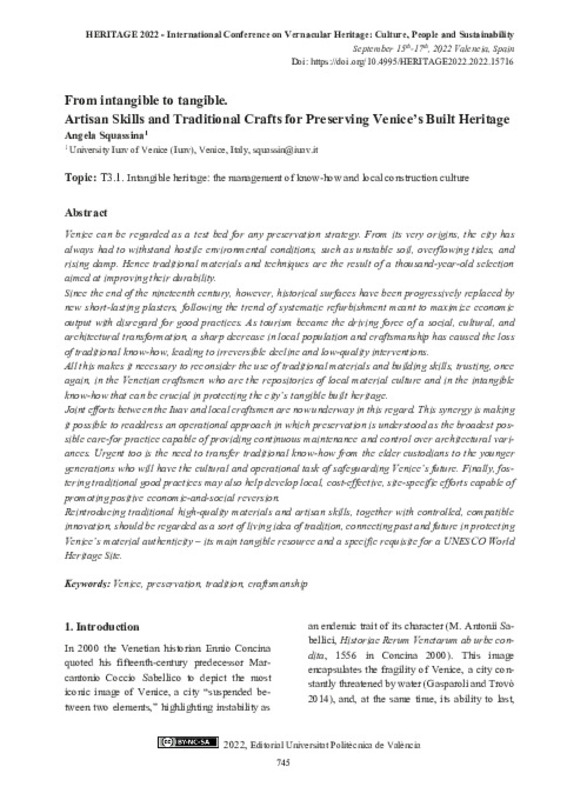JavaScript is disabled for your browser. Some features of this site may not work without it.
Buscar en RiuNet
Listar
Mi cuenta
Estadísticas
Ayuda RiuNet
Admin. UPV
From intangible to tangible. Artisan Skills and Traditional Crafts for Preserving Venice’s Built Heritage
Mostrar el registro sencillo del ítem
Ficheros en el ítem
| dc.contributor.author | Squassina, Angela
|
es_ES |
| dc.coverage.spatial | east=12.3155151; north=45.4408474; name=Venezia VE, Itàlia | es_ES |
| dc.date.accessioned | 2022-11-03T11:30:13Z | |
| dc.date.available | 2022-11-03T11:30:13Z | |
| dc.date.issued | 2022-09-13 | |
| dc.identifier.isbn | 9788413960203 | |
| dc.identifier.uri | http://hdl.handle.net/10251/189111 | |
| dc.description.abstract | [EN] Venice can be regarded as a test bed for any preservation strategy. From its very origins, the city has always had to withstand hostile environmental conditions, such as unstable soil, overflowing tides, and rising damp. Hence traditional materials and techniques are the result of a thousand-year-old selection aimed at improving their durability. Since the end of the nineteenth century, however, historical surfaces have been progressively replaced by new short-lasting plasters, following the trend of systematic refurbishment meant to maximize economic output with disregard for good practices. As tourism became the driving force of a social, cultural, and architectural transformation, a sharp decrease in local population and craftsmanship has caused the loss of traditional know-how, leading to irreversible decline and low-quality interventions. All this makes it necessary to reconsider the use of traditional materials and building skills, trusting, once again, in the Venetian craftsmen who are the repositories of local material culture and in the intangible know-how that can be crucial in protecting the city’s tangible built heritage. Joint efforts between the Iuav and local craftsmen are now underway in this regard. This synergy is making it possible to readdress an operational approach in which preservation is understood as the broadest possible care-for practice capable of providing continuous maintenance and control over architectural variances. Urgent too is the need to transfer traditional know-how from the elder custodians to the younger generations who will have the cultural and operational task of safeguarding Venice’s future. Finally, fostering traditional good practices may also help develop local, cost-effective, site-specific efforts capable of promoting positive economic-and-social reversion. Reintroducing traditional high-quality materials and artisan skills, together with controlled, compatible innovation, should be regarded as a sort of living idea of tradition, connecting past and future in protecting Venice’s material authenticity – its main tangible resource and a specific requisite for a UNESCO World Heritage Site. | es_ES |
| dc.format.extent | 8 | es_ES |
| dc.language | Inglés | es_ES |
| dc.publisher | Editorial Universitat Politècnica de València | es_ES |
| dc.relation.ispartof | Proceedings HERITAGE 2022 - International Conference on Vernacular Heritage: Culture, People and Sustainability | |
| dc.rights | Reconocimiento - No comercial - Compartir igual (by-nc-sa) | es_ES |
| dc.subject | Venice | es_ES |
| dc.subject | Preservation | es_ES |
| dc.subject | Tradition | es_ES |
| dc.subject | Craftsmanship | es_ES |
| dc.title | From intangible to tangible. Artisan Skills and Traditional Crafts for Preserving Venice’s Built Heritage | es_ES |
| dc.type | Capítulo de libro | es_ES |
| dc.type | Comunicación en congreso | es_ES |
| dc.identifier.doi | 10.4995/HERITAGE2022.2022.15716 | |
| dc.rights.accessRights | Abierto | es_ES |
| dc.description.bibliographicCitation | Squassina, A. (2022). From intangible to tangible. Artisan Skills and Traditional Crafts for Preserving Venice’s Built Heritage. En Proceedings HERITAGE 2022 - International Conference on Vernacular Heritage: Culture, People and Sustainability. Editorial Universitat Politècnica de València. 745-752. https://doi.org/10.4995/HERITAGE2022.2022.15716 | es_ES |
| dc.description.accrualMethod | OCS | es_ES |
| dc.relation.conferencename | HERITAGE2022 International Conference on Vernacular Heritage: Culture, People and Sustainability | es_ES |
| dc.relation.conferencedate | Septiembre 15-17, 2022 | es_ES |
| dc.relation.conferenceplace | Valencia, España | es_ES |
| dc.relation.publisherversion | http://ocs.editorial.upv.es/index.php/HERITAGE/HERITAGE2022/paper/view/15716 | es_ES |
| dc.description.upvformatpinicio | 745 | es_ES |
| dc.description.upvformatpfin | 752 | es_ES |
| dc.type.version | info:eu-repo/semantics/publishedVersion | es_ES |
| dc.relation.pasarela | OCS\15716 | es_ES |








